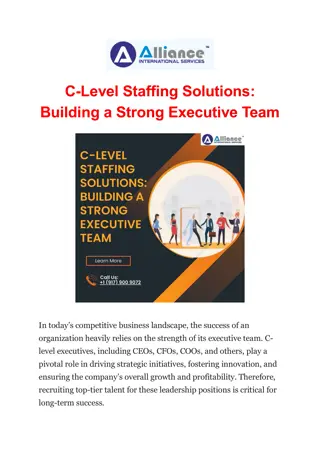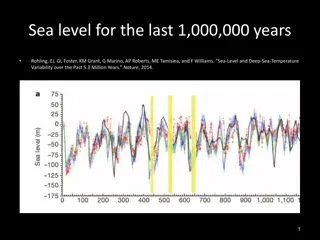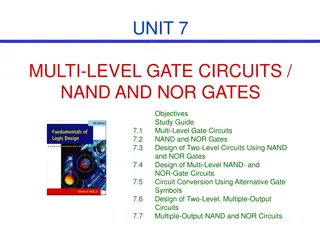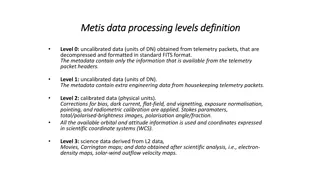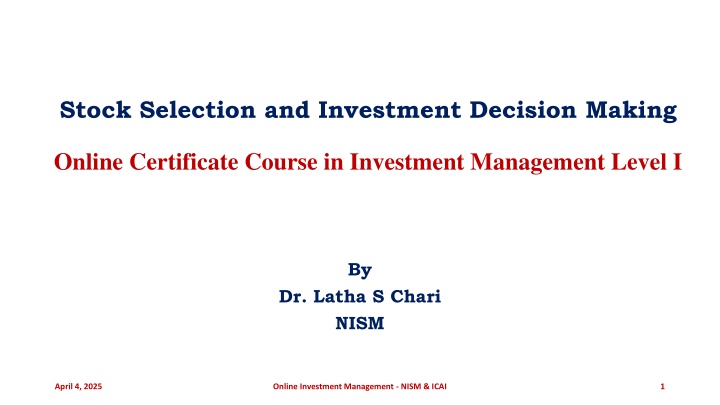
Investment Management Course in Stock Selection and Decision Making
Learn about investment products, equity investing, valuation methods, and sources of value in this online investment management course. Explore traditional and current investment products, equity analysis methods, and various valuation models to make informed investment decisions.
Download Presentation

Please find below an Image/Link to download the presentation.
The content on the website is provided AS IS for your information and personal use only. It may not be sold, licensed, or shared on other websites without obtaining consent from the author. If you encounter any issues during the download, it is possible that the publisher has removed the file from their server.
You are allowed to download the files provided on this website for personal or commercial use, subject to the condition that they are used lawfully. All files are the property of their respective owners.
The content on the website is provided AS IS for your information and personal use only. It may not be sold, licensed, or shared on other websites without obtaining consent from the author.
E N D
Presentation Transcript
Stock Selection and Investment Decision Making Online Certificate Course in Investment Management Level I By Dr. Latha S Chari NISM April 4, 2025 Online Investment Management - NISM & ICAI 1
Presentation Summary Investment products Equity Investing Valuation methods
Investment Products - Individuals Traditional products Real Estate, Gold, Silver (Real assets) Bank Fixed deposits, Post office savings schemes, Chit funds (Financial assets) Insurance Endowment policies, Money back policies (Risk management) Current Investment products Equity Primary market issue, Secondary market Mutual funds Equity, Balanced and debt schemes (Asset Class), Growth and Dividend (Income distribution), Open ended and Closed ended (Liquidity/Exit), Index funds and ETF, Thematic funds- International opportunities, Sectoral funds, Small cap funds etc. Gold Physical and Financial: Sovereign Gold bonds and Gold ETF, Gold derivatives REITS Financial Real estate Investment Corporate bonds, Non convertible debentures
Equity Investing Time Horizon Trading and Investment Analysis Methods Fundamental, Technical and Quantitative methods Fundamental Valuation models and News based trading Valuation Approach Discounted Cash flow and Relative valuation Stock Selection based on Investment Masters Value Investing and Growth Investing
Valuation Models Quick recap April 4, 2025 Online Investment Management - NISM & ICAI 5
Basic concepts Price Vs. Value Market value Vs. Book Value Trading value Vs. Transaction Value Value of the firm Vs. Value of equity Value of Equity Value of the - Value of debt (less cash) ie Bondholder value = operational business i.e Enterprise Value (Shareholder value) Enterprise value is the market value of net operational assets which must equal the market value of net funding THUS : EV = Market value of Equity + Market value of Debt - Cash
Sources of value - Valuation models Sources of Value Revenue, Earnings, Assets, Intangibles Based on the source of value the following models of valuation are used Net Asset value method (Assets) Dividend Discount Models (Net Earnings) Free Cash Flow Valuation (DCF) - (Earnings) Comparable Valuation Ratios (Multiples Valuation) (All)
Enterprise value Vs Balance Sheet Cash + Cash equivalents + Non controlled Investments + Non-core assets + Enterprise value (net operating assets) Debt (MV) Preference Shares Minority interest (MV PE) = - Financial Invest- Ments, Invt in associates Land banks Ordinary Equity value
Discounted Cash flow Method of Valuation Forecast the Income statement and Balance sheet 1 Arrive at the Free Cash Flow to Firm or Free Cash Flow to Equity 2 Calculate the Cost of capital 3 Discount the Cash flows with the cost of capital 4 Arrive at the terminal value. Aggregate the PV of Cash flows and terminal value to get Enterprise Value 5 Value of Equity = Enterprise Value Debt Minority Interest + Cash + Non core Assets + Non controlled Investments 6
Calculation of Free Cash Flow After excluding non operating incomes /expenses Exclude extra-ordinary items (for projections) EBIT Depreciation, amortization, other non cash expenses ADD Capital expenditure i.e. investment in operating assets (CAPEX) & Working capital increase Taxes (Tax on operating profits Interest) LESS FREE CASH FLOW TO FIRM GET Less interest payment and debt repayments Add Debt receipts ADD/L ESS FREE CASH FLOW TO EQUITY GET April 4, 2025 Online Investment Management - NISM & ICAI 10
Calculation of Cost of Capital kd: rate a company has to pay for its debt. Current YTM of the debt security or Look at YTM of securities with same credit rating and maturity or interest charged for loans in the near past/prevailing in the market now.
Discounted Future cash flows April 4, 2025 Online Investment Management - NISM & ICAI 12
Forecasting FCF Inputs Things to take care Sales forecast Segment forecasting All costs and EBIT as a % of sales Depreciation % of GB, + depreciation on Additional CAPEX Tax rate Marginal tax rate based on budget OR Some use the effective tax rate if found to be consistent across years CAPEX not easy to forecast. Depends on firms depreciation and business plan, MDA, business cycles. STEADY state Capex > Depreciation Working capital Pure working capital forecasting or Net working capital forecasting. Generally use inventory, debtors as % of sales. Creditors as % of sales Steady state State at which the company reaches maturity w.r.t. cash flows
Critical Elements - DCF Assumptions - Reliable Revenue projections Futuristic Include Sensitivity Analysis WACC and Long term growth rate Can do a Scenario analysis Best case, Regular case and Worst case
Relative Valuation Methods OR Comparable valuation Uses the market perception of company s value relative to peers. Trading comparable Meant for Retail Investment Transaction Comparable Used for Merger and Acquisition. Includes Control premium/Control discount Two Types of Valuation Multiples Price Multiple Price Earnings, Price to Sales, Price Earnings Growth, Price to Book Value Value Multiple Enterprise Value (EV) to Sales, EV to EBIT, EV to EBITDA Other Multiples EV/Oil reserves, EV/Subscribers, EV/Sq feet of asset, EV/Employee, EV/Production
Relative Valuation Steps Screen for best Comparable peer group Similar industry product mix, Same size capital, asset, revenue Geographical reach Growth prospects Business model Key customers product positioning Cost and Capital structure Ownership structure Get general company data, share data Calculate Enterprise value Find recurring earnings number Complete projected numbers
Critical Appreciation of Methods Discounted Cash flow Method Early stage companies and Distressed companies pose challenges Very sensitive to changes in Cost of capital and long term growth rates Can be applied only for long term investment decision making If reinvestment rate is high such companies are undervalued in DCF Assumes steady state in Valuation. Companies strive not to reach steady state Relative Valuation methods Difficult to find comparable companies Can be misleading when markets are generally overvalued or depressed.




